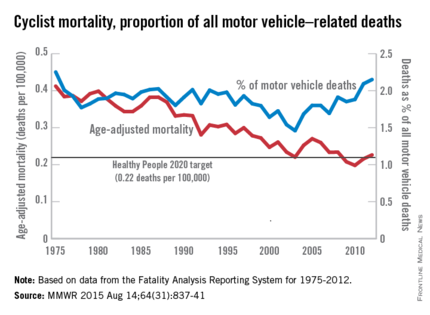The annual rate for bicyclist deaths associated with motor vehicles dropped 44% from 1975 to 2012, but the downward trend has slowed in recent years, the Centers for Disease Control and Prevention reported.
Annual mortality among cyclists for all motor vehicle–related deaths was 0.23 per 100,000 in 2012, a decline of 44% since 1975 when the rate was 0.41 per 100,000. But the rate is up from just under 0.20 per 100,000 in 2010. In 2012, the rate topped the Healthy People 2020 goal of 0.22 for the first time since 2008, according to Jason Vargo, Ph.D., of the University of Wisconsin, Madison, and his associates (MMWR. 2015 Aug 14;64[31]:837-41).
Similarly, the proportion of cyclist deaths among all motor vehicle–related deaths was 2.25% in 1975, and dropped to a low of 1.46% in 2003. Since then, however, the rate has risen steadily and in 2012 stood at 2.15%, the highest rate since 1975.
The explanation may be that the number of bicyclists has been steadily rising. “The share of total household trips taken by bicycle has doubled over the last 35 years” with the largest share of that increase occurring in recent years. From 2000 to 2012, for example, “the number of U.S. workers who traveled to work by bicycle increased 61%,” the researchers wrote.
The report was based on data from the Fatality Analysis Reporting System, which limits fatalities to those involving a motor vehicle on a public road.

